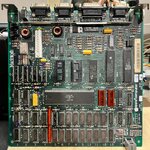You're absolutely right about the refresh rates! I completely missed that aspect. Regardless, your explanation was incredibly helpful and provided a much clearer, broader understanding of how RAM functions in the early Macs.
What I meant in the part about refresh rates was more about the address lines than actual rates. I was originally confused about that chip having an A11 pin, because A10 should be the MSB for that size of memory chip. Then I noticed the little blurb in the datasheet block diagram regarding the address signals. I don’t really understand how one would implement the 4K refresh type with the strange address line usage, but I guess that doesn’t really matter for this project.
I’ll admit I haven’t looked into the timing aspect of any of this yet. I’m just crossing my fingers that I’m not adding too much propagation delay and it’ll just work. Hopefully faster memory will make up for it? If it doesn’t work out, and I can always poke around with the scope and see what we can see.
I’m sort of figuring this out on the fly, so don’t take any perceived confidence on my end as credibility

This has very much been a learning opportunity for me. In this thread, I’m mostly thinking out loud hoping others will catch any misunderstandings I may have. However it is not my intention to spread misinformation if I am thinking about any of this incorrectly.
Back in college, it was a pretty common occurrence for me to confidently convince everyone else in my group to believe or think a certain way, just for me to eventually realize I misunderstood something and had to backtrack. So sorry if there’s some whiplash, and I end up going in a different direction.
I really appreciate the dialog. This is the sort of thing I was hoping for when posting.
By the way, I’ll try to hone in on redrawing the schematics soon and spend less energy on scope creep for now. We can always circle back to fancy mouse click memory upgrade disabling and SCSI stuff in the future.


